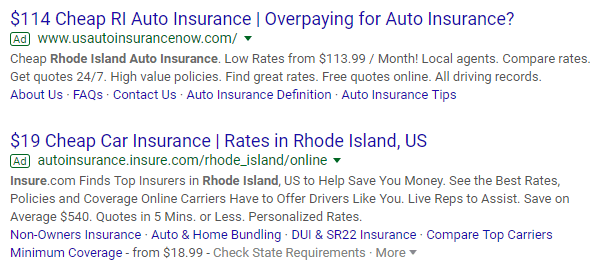
If you’ve read any ‘Top Marketing Strategies’ list in the past couple of years, you know pay-per-click (PPC) ads are always a popular recommendation.
And for good reason.
Google AdWords campaigns produce one of the strongest returns on investment for organizations. Studies have shown for every dollar companies spend on pay-per-click advertising, they earn two dollars on average from Google Ads.
While these conversion rates are the case for some, not all advertisers generate the same number of leads with this advertising channel.
If your PPC ads are not converting, it could be for several reasons such as:
- You’re not using the right keywords
- Your ad copy is not compelling enough
- Your landing page lacks a good user experience
You could spend a lot of time and money trying to figure out what changes to make, with no guarantee it’ll actually work.
Instead, consider utilizing ad concept testing with your target audience to understand what keywords, ad copy, design, and landing page features they’d most likely take action on.
Here’s how.
Concept Test Your PPC Ads
When wondering how to get leads with PPC ads, many experts will tell you to mirror the objectives of your target audience. They’ll recommend putting yourself in the shoes of your customers.
This exercise is supposed to help you learn what problems customers are experiencing and how they’d search for a solution.
While I agree with the sentiment, the exercise is still based on assumptions of your buyers’ opinions and purchasing habits. It’s still not a data-driven marketing strategy.
Why not instead of ‘putting yourself in their shoes’ go straight to the source and ask for their feedback?
- What are their biggest pain points?
- What everyday problems are they experiencing?
- How does your type of product/service help overcome their pain points?
- Where do they look for your type of product/service?
- What phrases do they use to search for your type of product/service?
All of which can be answered in an online survey with those you identify as your target buyer.
Going one step further, stop A/B testing your ads on Google. Instead, utilize the survey to concept test which ad copy is most effective.
Working with a market research company like Drive Research, you’ll be able to survey respondents and can be shown different messaging tactics. You’ll earn measurable and actionable data based on what they like, don’t like, what stood out to them, and more.
We dive into the process of this type of market research (and much more) in our Ultimate Guide to Ad Concept Testing.
Watch our video to learn more about the benefits of ad concept testing with surveys.
💡The Key Takeaway: The best way to produce PPC ads that convert is to understand the pain points of your target buyers, and explain how your product/service can solve them. By surveying your customers and non-customers you can learn exactly what these are, rather than basing it off assumptions.
How to Write Good PPC Ads with the Data
Once the concept testing survey is finished, it’s time to act on the data.
What keywords did survey respondents say they’re likely to use when searching for your product/service? Incorporate those words or phrases into the ad title and description.

What were the top value propositions did respondents find most enticing? Was it free shipping, low costs, free trial? Whatever it may be, it needs to be included in your ad and landing page.

What does your audience say sets you apart from competitors? I won’t even say it, you know what to do with that information!

The concept testing survey can go beyond ad copy and design, but also can touch on things like sources of awareness.
For instance, where does your audience go to search for your type of product or service? Maybe it’s not Google. Perhaps Amazon PPC ads or paid social media is a better bang for your buck.
Outside of the custom data you obtain, here are other helpful tips to make sure your PPC ads convert:
- Include a creative call to action
- State your price point (if possible)
- Use emotional triggers
- Include number or stats in your headlines
💡The Key Takeaway: Ad concept surveys basically write your Google AdWords titles and descriptions for you. Better yet, they’re inspired by accurate data and feedback directly from target buyers. No more assumptions or best guesses!
What to Do When You’re Getting a Good CTR, But Not Converting
In order to make money from pay-per-click ads, you need more than a strong click-through rate (CTR). You need form fills.
The good news is that your advertisement is generating enough interest that people are choosing to navigate to your website to learn more.
The bad news is that they don’t like what they see once they get there.
In this scenario, it’s worth taking a closer look at your landing page.
- Is some type of form fill at the top of the fold, or easily navigable?
- Is the messaging clear?
- Does the page load too slow?
- Are there enough testimonials or client reviews?
- Are your prices too high?
Unfortunately, the possibilities are endless. The only try and true way to pinpoint why you’re getting a good CTR, but not converting leads is by using market research.
This could be achieved through concept testing surveys similar to the example above, or with user experience market research.
In fact, we’ve worked with clients who have seen as much as 665% higher website conversion rates by doing this (more on that, here).
Improving landing page conversions with moderated UX interviews
Via a remote share screen, a facilitator watches as a participant views and navigates through your landing page. Participants are asked to complete certain tasks such as finding pricing information or filling out a contact form.
This approach creates more one-on-one conversations and questions. For instance, after a task is completed a moderator can ask if the content was clear, if it was easy to navigate, if the imagery was appealing, etc.
Improving landing page conversions with unmoderated UX
In this approach, there is no facilitator guiding participants. Instead, those who match your ideal target audience, are asked to download an app. Here, there are given several tasks to accomplish individually.
While they are completing the assigned tasks, participants record their screens and verbally express their thought processes. Additionally, participants must complete a short survey after they’ve completed the tasks. The survey can dive into landing page likes/dislikes, suggestions, likelihood to convert, and more.
💡The Key Takeaway: Having a high CTR on your Google Adwords campaigns is a good start. But, if you’re not seeing conversions then it’s time to take a better look at the landing page. We recommend utilizing UX market research for a clear path forward.
Contact Our Marketing Research Company
Drive Research is a national market research company specializing in qualitative and quantitative studies. We’ve worked with brands such as Ulta, Pinterest, as well as many B2B brands on ad concept testing. They’ve used our findings to launch data-driven marketing campaigns that convert.
To learn more about our services, contact our team today.
- Message us on our website
- Email us at [email protected]
- Call us at 888-725-DATA
- Text us at 315-303-2040

Emily Rodgers
A SUNY Cortland graduate, Emily has taken her passion for social and content marketing to Drive Research as the Marketing Manager. She has earned certificates for both Google Analytics and Google AdWords.
Learn more about Emily, here.

